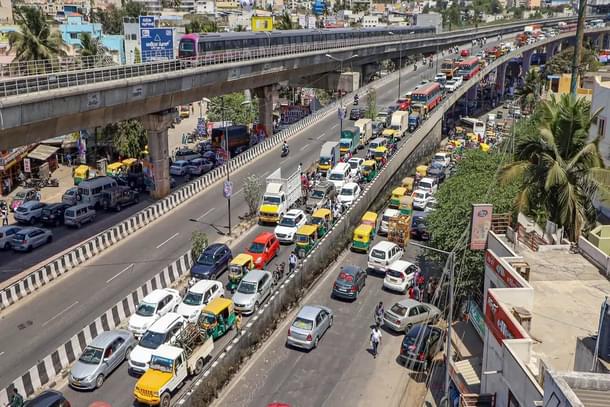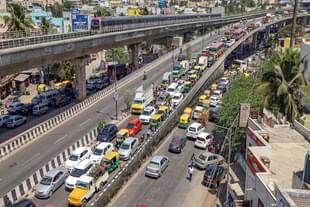Infrastructure
Last-Mile Connectivity: How Can Bengaluru Solve Its Metro's Biggest Challenge?
V Bhagya Subhashini
May 28, 2024, 03:13 PM | Updated 03:13 PM IST
Save & read from anywhere!
Bookmark stories for easy access on any device or the Swarajya app.


Last-mile connectivity has long been a significant gap in Bengaluru’s Namma Metro scheme. As the metro expanded across the city, this gap became a perennial sore point.
However, the introduction of Bangalore Metropolitan Transport Corporation (BMTC) Metro Feeder buses has begun to address this issue, raising an important question: can last-mile connectivity be enhanced by players beyond BMTC?
For years, commuters relied on their cars or two-wheelers to bridge the gap between home and metro stations, and from stations to workplaces.
This not only added to the city's congestion but also highlighted the lack of adequate parking spaces at metro stations. Feeder shuttle bus services were seen as a potential solution.
The Case For Mini Buses
Pawan Mulukutla, Executive Director of the Transport and Clean Air Programme at the World Resources Institute (WRI) India, suggests deploying 15-seater or 20-seater mini buses instead.
"Bengaluru has significant congestion issues with narrow roads around metro stations. Our regular big buses will not work. Mini buses will also be more economical and competitive," he explains.
Pawan advocates a systematic feeder system with a dedicated 'last-mile cell' at the Bangalore Metro Rail Corporation Limited (BMRCL) to manage commuter data. Aligning the frequency of feeder buses with peak and off-peak hours, based on commuter patterns, would enhance the effectiveness of the metro service, reports The Hindu.
The Metro Mithra Experience
Autorickshaws could also play a role if managed professionally with a predefined fare structure. The Metro Mithra service is aimed to achieve this but faces challenges. Security issues and unprofessional behaviour by some drivers prevented Metro Mithra autos from getting parking spaces at stations.
Better coordination between police, BMRCL and security guards is needed to ensure smooth operations.
Collaboration of Bengaluru metro and Namma Yatri is a welcome step. As part of this initiative, BMRCL, Namma Yatri and the Bangalore Traffic Police are developing a specialised app for metro commuters.
This app will enable passengers to seamlessly book autorickshaws from their nearest metro stations, ensuring safe and reasonably priced travel options.
Community-Driven Solutions
Local communities could also contribute by running minibuses on a private-public partnership (PPP) model. Pawan Mulukutla suggests, "Residents’ welfare associations (RWAs) in areas like J P Nagar–Konankunte could run community minibuses, encouraging more people to use the metro."
BMTC can use its branding and planning while involving other players in operating these services. This innovative approach could significantly improve last mile connectivity.
Enhancing The BMTC Feeder Ecosystem
Within the BMTC Metro feeder ecosystem, there are areas for improvement. Feeders should serve internal areas within 3-4 km of a metro station. Services running on the same route as regular buses, like the 500A and 500B between K R Puram and Silk Board, don’t qualify as metro feeders.
Increasing Awareness
Awareness of feeder services is crucial. While BMTC releases information through newspapers and social media, many commuters miss these updates.
Displaying bus timings and routes within the train and at station entrances/exits could help. In-train announcements about available feeders as the train approaches a station would also be beneficial.
Expanding The Network
As of March, the network of metro feeder buses had expanded to 151 services across 43 stations, with plans to increase to 300 services. An estimated one lakh people use these buses daily.
BMTC has also installed QR code scanners at all stations, allowing commuters to live-track feeder buses through the BMTC website.
By addressing last mile connectivity through a combination of innovative solutions and enhanced feeder services, Bengaluru can significantly improve the overall efficiency and appeal of its Namma Metro system.
V Bhagya Subhashini is a staff writer at Swarajya. She tracks infrastructure developments.





